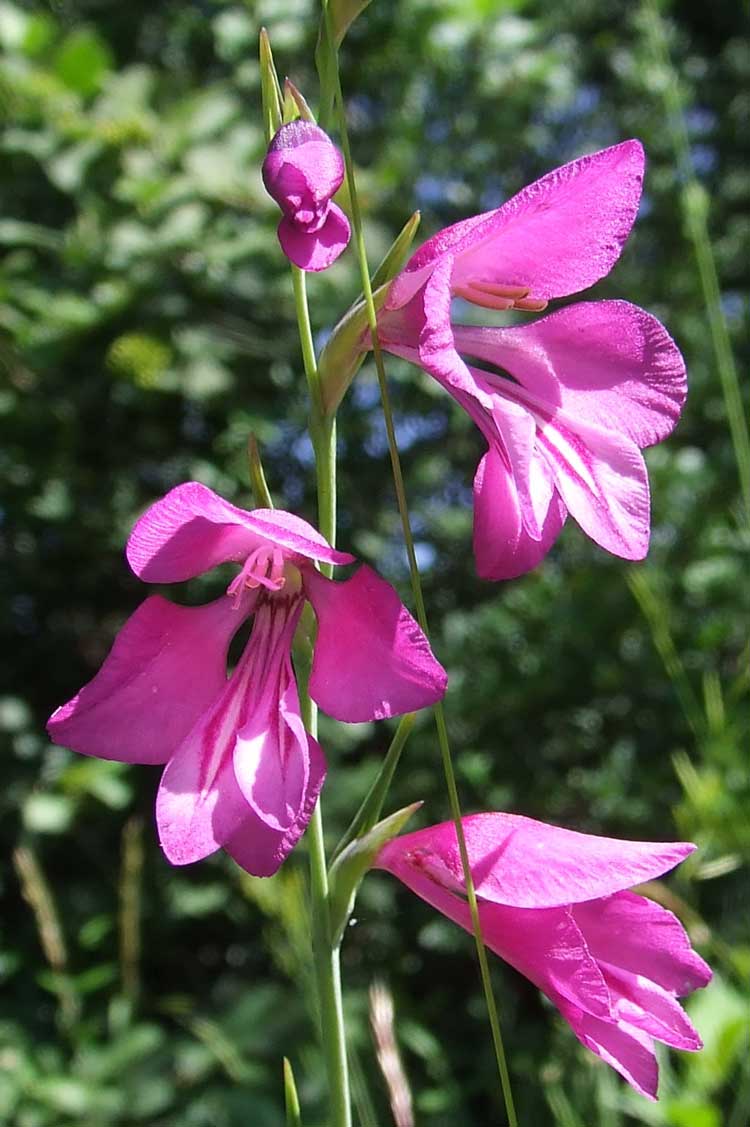
Gladiolus palustris (*)
Classification System: APG IV
Superregnum: Eukaryota
Regnum: Plantae
Cladus: Angiosperms
Cladus: Monocots
Ordo: Asparagales
Familia: Iridaceae
Subfamilia: Crocoideae
Tribus: Gladioleae
Genus: Gladiolus
Subgenus: G. subg. Gladiolus
Sectio: G. sect. Gladiolus
Species: Gladiolus palustris
Name
Gladiolus palustris Gaudin, Fl. Helv. 1: 97. 1828.
Synonyms
Homotypic
Gladiolus communis subsp. palustris (Gaudin) Bonnier & Layens, Tabl. Syn. Pl. Vasc. France: 305 (1894).
Heterotypic
Gladiolus boucheanus Schltdl., Linnaea 7: 488. 1832.
Gladiolus felicis Z.Mirek, Acta Soc. Bot. Poloniae 54: 161. 1985.
Gladiolus imbricatus subsp. parviflorus K.Richt., Pl. Eur. 1: 260. 1890.
Gladiolus parviflorus Berdau, Fl. Cracov.: 341. 1859, nom. illeg.
Gladiolus pratensis A.Dietr., Fl. Boruss. 1: 43. 1833.
Gladiolus triphyllus Bertol., Mant. Pl. Fl. Apuan.: 5. 1832, nom. illeg.
Distribution
Native distribution areas:
Continental: Europe
Regional: C. & E. Europe
Albania, Austria, Baltic States, Belarus, Bulgaria, Czechoslovakia, France, Germany, Greece, Hungary, Italy, Northwest European Russia, Poland, Switzerland, Ukraine, Yugoslavia
References: Brummitt, R.K. 2001. TDWG – World Geographical Scheme for Recording Plant Distributions, 2nd Edition
References
Primary references
Gaudin, J. 1828. Flora Helvetica; sive, Historia stirpium hucusque cognitarum in Helvetia et in tractibus counterminis aut sponte nascentium aut in hominis animaliumque usus vulgo cultarum continuata. Vol. 1. Turici, Sumptibus Orellii, Fuesslini et Sociorum. BHL Reference page. : 97
Additional references
Govaerts, R.H.A. 2003. World Checklist of Selected Plant Families Database in ACCESS: 1-216203. The Board of Trustees of the Royal Botanic Gardens, Kew. [unavailable for the public] Reference page.
Links
Govaerts, R. et al. 2022. Gladiolus palustris in World Checklist of Selected Plant Families. The Board of Trustees of the Royal Botanic Gardens, Kew. Published online. Accessed: 2022 Jan 28. Reference page.
Hassler, M. 2022. Gladiolus palustris. World Plants: Synonymic Checklists of the Vascular Plants of the World In: Roskovh, Y., Abucay, L., Orrell, T., Nicolson, D., Bailly, N., Kirk, P., Bourgoin, T., DeWalt, R.E., Decock, W., De Wever, A., Nieukerken, E. van, Zarucchi, J. & Penev, L., eds. 2022. Species 2000 & ITIS Catalogue of Life. Published online. Accessed: 2022 Jan 28. Reference page.
Tropicos.org 2022. Gladiolus palustris. Missouri Botanical Garden. Published online. Accessed: 28 Jan 2022.
International Plant Names Index. 2022. Gladiolus palustris. Published online. Accessed: Jan 28 2022.
Vernacular names
čeština: Mečík bahenní
Deutsch: Sumpf-Gladiole
English: Marsh Gladiolus
فارسی: گلایول شمشیری
suomi: Nuokkumiekkalilja
français: Glaïeul des marais
magyar: Mocsári kardvirág
italiano: Gladiolo palustre
lietuvių: Pelkinis kardelis
polski: Mieczyk błotny
русский: Шпажник болотный
slovenčina: Mečík močiarny
slovenščina: Močvirski meček
svenska: Kärrsabellilja
українська: Косарики болотні
Gladiolus palustris, common name marsh gladiolus or sword lily, is a herbaceous perennial plant belonging to the genus Gladiolus of the family Iridaceae. The genus name Gladiolus is the Latin diminutive of gladius, a sword, while the specific Latin name palustris, meaning growing in marshes, refers to the alleged environment of this species.
Contents
1 Description
2 Gallery
3 Distribution
4 Habitat
5 References
6 External links
Description
Gladiolus palustris reaches on average 30–60 centimetres (12–24 in) of height. The stem is erect, glabrous and unbranched, the bulbus is spherical with cross-linked fibers at the top. The leaves are shorter than the stem, simple, with a parallel venation, sword-shaped, 4–9 centimetres (1.6–3.5 in) long. The inflorescence is composed of three to six hermaphroditic flowers, trifoliate, with a rosy violet or magenta perigonium, about 30 centimetres (12 in) long. The flowering period of these plants extends from May through July. They are pollinated by bumblebees.
Distribution
This species is native of Central and NW Europe. It occurs in eastern France, Switzerland, in southern and eastern Germany, the Czech Republic, Slovakia and Poland. It is present in the Italian Alps, Austria and Hungary and more common in the Balkan region. Other locations are in Eastern Europe, including Romania.[3]
Habitat
Notwithstanding the name, these plants do not grow in marshes, as they prefer calcareous, moist and humus rich environments alternately wet and dry, in wet meadows and forest clearings. They can be found at a maximum altitude of 1,200–1,500 metres (3,900–4,900 ft).
References
Bilz, M. 2011. Gladiolus palustris. The IUCN Red List of Threatened Species 2011: e.T162188A5555329. https://dx.doi.org/10.2305/IUCN.UK.2011-1.RLTS.T162188A5555329.en. Accessed on 04 May 2022.
Gladiolus palustris Gaudin | Kew Science. (n.d.). Plants of the World Online. Retrieved May 4, 2022, from https://powo.science.kew.org/taxon/urn:lsid:ipni.org:names:437708–1
Miu, Iulia V.; Rozylowicz, Laurentiu; Popescu, Viorel D.; Anastasiu, Paulina (2020). "Identification of areas of very high biodiversity value to achieve the EU Biodiversity Strategy for 2030 key commitments". PeerJ. 8. doi:10.7717/peerj.10067. PMC 7532765.
Pignatti S. - Flora d'Italia - Edagricole – 1982
Retrieved from "http://en.wikipedia.org/"
All text is available under the terms of the GNU Free Documentation License

